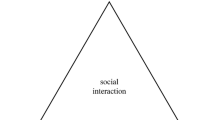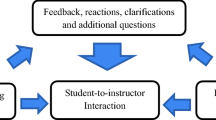Abstract
This paper draws on two studies which researched the use of online small group environments where collaborative learning is a central structure for learning. The establishment of social presence is facilitated through the socio-affective aspect of small group interaction which contributed to the effectiveness of learning online. Social presence, the ability of online learners to project themselves into a textual environment which has few visual or contextual cues, will be explored as an important element in facilitating effective online learning. The teacher's role in helping students project their online social presence and in establishing an environment for learning within the larger group computer conference will also be discussed.
Similar content being viewed by others
References
Culnan, M. J. and Markus, M. L. (1987) Information technologies. In Handbook of Organisational Communication: An Interdisciplinary Perspective, F.M. Jablin, L. Putnam, K. H. Roberts, and L.W. Porter (eds). Newbury Park, CA. (Sage cited in (Walther, 1996).)
Forman, E. A. and McPhail, J. (1993) Vygotskian perspective on children's collaborative problem-solving activities. In Contexts for Learning: Sociocultural Dynamics in Children's Development, E. A. Forman, N. Minick, and C. A. Stone (eds). Oxford University Press, New York, pp. 213–229.
Garrison, D. R. (1997a) Computer conferencing and distance education: Cognitive and social presence issues. In The New Learning Environment: A Global Perspective, Proceedings of the ICDE World Conference, Pennsylvania State University.
Garrison, D. R. (1997b) Computer conferencing: The post-industrial age of distance education. Open Learning, June, 3–11.
Gunawardena, C. N. and Zittle, F. (1997) Social presence as a predictor of satisfaction within a computer-mediated conferencing environment. American Journal of Distance Education, 11(3), 8–26.
Hara, N., Bonk, C. J., and Angeli, C. (2000) Content analysis of online discussion in an applied educational psychology. Instructional Science, 28(2), 115–152.
Lindlif, T. R. and Shatzer, M. J. (1998) Media ethnography in virtual space: Strategies, limits, and possibilities. Journal of Broadcasting and Electronic Media, 42(2), Spring, 170–189.
Parks, M. R. and Floyd, K. (1996) Making friends in cyberspace. Journal of Communication, 46(1), 80–90.
Rice, R. E. (1993) Media appropriateness: Using social presence theory to compare traditional and new organisational media. Human Communication Research, 19, 451–484. (Quoted in (Lindlif and Shatzer, 1998).)
Rourke, L., Anderson T., Garrison, D. R., and Archer, W. (1999) Assessing social presence in asynchronous text-based computer conferencing. Canadian Journal of Distance Education, 14(2), 50–71.
Stacey, E. (1999) Collaborative learning in an online environment. Canadian Journal of Distance Education, 14(2), 14–33.
Vygotsky, L. S. (1978) Mind in Society: The Development of Higher Psychological Processes, M. M. Cole, Lopez-Morillas, A. R. Luria, and J. Wertsch (trans.). Harvard University Press, Cambridge, MA.
Walther, J. B. (1993) Impression development in computer mediated interaction. Western Journal of Communication, 57, 381–398.
Walther, J. B. (1996) Computer-mediated communication: Impersonal, interpersonal, and hyperpersonal interaction. Communication Research, 23(1), 3–41.
Walther, J. B. and Burgoon, J. K. (1992) Relational communication in computer mediated interaction. Human Communication Research, 19, 50–88.
Author information
Authors and Affiliations
Rights and permissions
About this article
Cite this article
Stacey, E. Social Presence Online: Networking Learners at a Distance. Education and Information Technologies 7, 287–294 (2002). https://doi.org/10.1023/A:1020901202588
Issue Date:
DOI: https://doi.org/10.1023/A:1020901202588




